Chennault comes to China:.
Claire Lee Chennault was an American civilian when he arrived in China at the request of Generalissimo Chiang and his wife in 1937. True enough, Chennault had held Captain’s rank in the US Army Air Corps. He missed WW I and actually took private lessons to become a pilot before joining the AAC; he’d performed aerial maneuvers within that organization, but he had never flown in actual combat.
Chennault had been retired due to bad health by the Army. However, he was also a theorist and his ideas were not easily accepted by most American military who envisioned the role of the heavy bomber as strategic in winning wars. Chennault’s ideas that smaller more highly maneuverable fighter aircraft were capable of bringing down these heavily armored behemoths; preventing them from reaching their targets, was at odds, and certainly unproven. But it was published and widely available in aeronautical journals of the times.
China was in a battle for its very existence as a sovereign nation; struggling to stay alive after invasion by its island-neighbor, Japan. The Japanese had come for raw materials, food, exploitation of China’s vast labor reserves, and to drive a wedge between their Pacific conquests and an old foe, Russia – who they had defeated in 1905, but feared their re-emergence as an industrial power with military might. China offered little initial resistance to Japan’s advances, and the Japanese used terror-tactics to further subdue China’s populace – that of indiscriminate and continuous bombing of China’s cities. By 1937 Japan was virtually unopposed in the skies.
China lacked not in number of troops, but in modern weaponry, and most of all – it’s be-draggled air force was disorganized, scattered, and its useable aircraft few, due to inefficient operation by several European nations who had been engaged to help modernize it. By the time these discrepancies came completely to light, the Axis powers had begun conquering portions of Europe; Japan had an invite to join them and the then free world began to occupy itself in defensive posturing. Those few nations who saw China’s needs, realized their own were more immediately important. In effect, it was hoped China could hold her own….
China, of course was fighting for its very life - its peoples barely united against an old foe. A wide-reaching agrarian culture; with an ancient history of conscription of villagers to fight for their emperor, which just a quarter-century previously had risen up against the feudal system to become a Republic. But, far from totally united, China’s government was still fractionalized by war-lords; divided by ideologies and now under attack by a well-organized & equipped military force. China did not lack for energetic or loyal pilots, it suffered from poor & improper training and equipment…
Into this mess – stepped a weather-beaten, half-deaf, heavy-smoker with a bad case of bronchitis; a civilian, ex-Army Captain from America with an undefined plan! He had arrived at the invitation of the Chiangs to assess and re-organize the Chinese Air Force; eventually he was given the honorary rank of Colonel in the Chinese Air Force.

© Flying Tiger Historical Organization. Optimized for a screen resolution of 1024x768, using IE7+
501 (c) 3 OrganizationTax ID 26-1492466
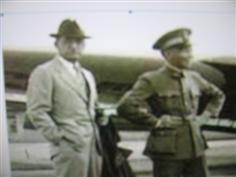
In the days that lay ahead, Chennault would discover that less than 200 air-worthy planes, scattered in airfields from Hankow to Chunking made up the entire disorganized CAF conglomeration. Most were American-built bi-planes; outdated badly by the modern Japanese fighters and bombers. These were interspersed with scattered Italian and even a few German-made twin-engine bombers – haphazardly deployed. The Air Force, listed as consisting of 2,200 planes barely existed at all! Some, without engines might prove repairable for spotter planes & reconnaissance only, while hundreds more lay in pieces in repair facilities without technical staff or parts.
As for pilots, Chennault was to discover there were two kinds, those still alive with experience, and eager young recruits with poor training who had barely-solo’d. Some of the better pilots were still prima-donnas from wealthy families… they looked down on the recruits, refusing to fly with them. The hierarchy and intolerance would best be dissolved by equalizing the training for all… so Chennault invited his friends and ex-flying buddies to help in training a new air force.
The empty parts bins tell the story here. Mean-time - the Chaings bought some more modern aircraft, and this attracted mercenaries who’d flown in minor wars and skirmishes from Spain & Africa to the middle-east. These loosely formed the International Volunteer Corps. They were highly paid ($1,000 USD/mo.) and while having some success against the Japanese, were also heavy drinkers, carousing the local pubs and ‘houses of ill-repute’. While it is known that three of Chennault’s friends exercised raids on enemy positions with this group, it’s surmised that Chennault, himself – if not a participant, did much of the planning. It was still when some semblance of training Chinese pilots was going on, that the IVC was active (1937-’38)…. Perhaps it might be called: “The only game in town” – and why miss the experience?
Washington also had its eyes on the goings on in China. Officially, it was understood that America was a neutral nation; still selling fuel & raw materials to Japan. Federal law forbid an American from participating in a war for a foreign nation; punishable by loss of one’s citizenship. So, you wont find much mention of American Soldiers of Fortune… but indeed the IVC had drawn Washington’s criticism. FDR, while sympathetic, and secretly aiding China, publicly criticized the IVC, His wife, Elanore, called them “Alley Cats” (a name which they adopted, as identification, wearing patches with a bristling black cat). It wasn’t this which put an end to their activities, however.
After a few successful raids, they fueled, filled the bombays, and armed their 22 Lockheed Hudsons for a raid against the Japs … then went about their normal evening activities. The next day they arose late – much too late… and found all 22 aircraft completely destroyed in an early morning raid by the Japanese. There was no doubt that some spy at bar or brothel sent word of their boasts to destroy the Japanese. A few members continued flying fighters for the next couple months, but by April of 1938, the IVC disappeared and hardly a historical record exists.
Chennault recruited more Americans to help train the CAF… men like Jimmy Doolittle, Art Chen, George Weigle and Jim Allison. They all contributed to China’s amazing Air Force recovery program, and Doolittle of course, was chosen for the carrier-based bomber raid on Tokyo in 1942.
Along with Chennault, his training and his setting-up a Chinese early warning net in 1939-’40 we need not forget the Russians who came to aid the Chinese thru a sort of lend-lease/purchase aircraft plan that also allowed Soviet pilots to train (and indeed, participate in action against the Japanese). In fact, the largest number of fighter aircraft purchased by the Chinese government were Pllikarpove I-15s and I-16s; quite well-built and agile aircraft. Unfortunately, Russia withdrew her support to combat the German attacks on her eastern front in 1940, and while volume of these fighters were great, the Chinese airmen trained to fly them was not!
Both Chennault and the Chinese seemed to have a ‘love affair’ with Curtiss-Wright aircraft. That corporation considered developing manufacturing facilities within China itself. During the remainder of 1940 and into 1941, China tried unsuccessfully to purchase B-17's, and modern fighters from the United States. A few American manufacturers set up facilities to build aircraft in China, these became targets for Japanese bombers, and while not totally successful many Chinese became well-trained in aircraft assembly and mechanics… but the experience gained, was to be a great aid to America and her allies later.
Additional airfield construction was begun during this pre-war period as both the Chiangs and Chennalult envisioned that advances by Japanese army and air force would surely render many existent bases as untenable in the foreseeable future. Amazingly there was a coolie force of over 200,000 mobilized for this back-breaking endeavor. They moved from region to region adding locals as necessary. Their equipment was meager – a few hammers, picks, shovels. The rest they built on site. No one seems to know the exact origin of the methods used, but the availability of stone, preferably lime-stone and water to make the mud-slurry which held it all together; the ability to build stone or concrete rollers for compacting by human endeavor and the ropes to harness the pullers – all were produced on site.
Since mechanization was unavailable, China’s airfield construction techniques became the most-photographed operation of WW II. The same methods were used throughout the war, in every place (until the later B-29 bases were constructed
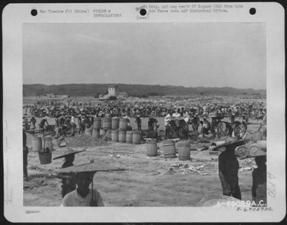
Literally thousands of workers descended on the locations; digging, scouring, hauling & leveling - looking like ants in a sand-pile from a distance, Americans viewed it as inefficient, yet amazing to watch.
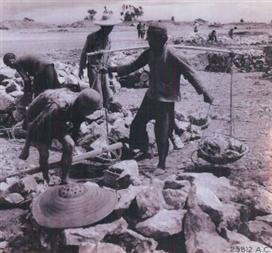
Hand hauled by the crudest of methods, broken into smaller pieces as succeeding layers were laid atop each other. “Cemented’ by a mud slurry into a flat level runway for bomb-laden or fighter aircraft. Repair could be effected over-night should the enemy bomb them. Virtually all runways in China during the war were made this way…
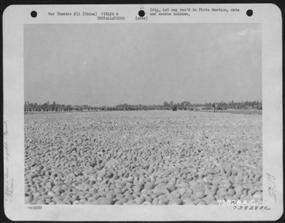
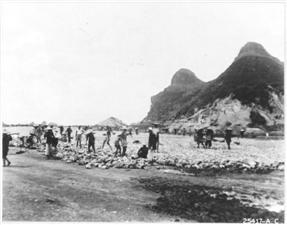
Airfields took shape within weeks with thousands of workers constantly, filling and rolling the surfaces with smaller & smaller stone layers…
LEFT & RIGHT: First layment of large stones completed.
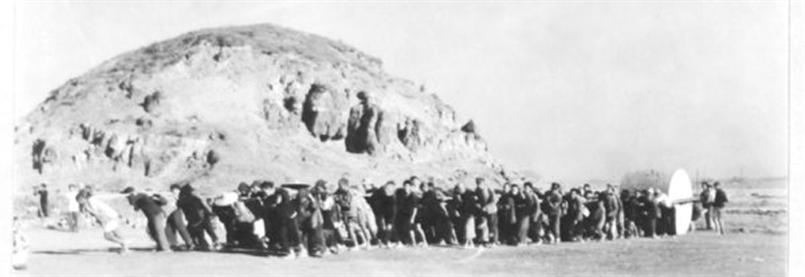
ABOVE: This, the largest stone-roller required up to 900 men pulling it, and weighed 50,000-Lbs. It required greater numbers to move on initial layments of the largest stones!
As the size of the stones decreased a watery slurry of mud was compacted in to ‘cement’ them together … sometimes delivered in barrels, other times pumped from a dug well.
[ top of page ]

ABOVE: C.L. Chennault and
Gen. Chow Cho Jou

















